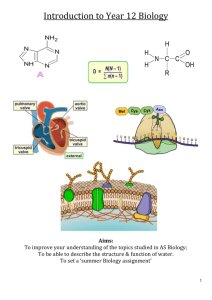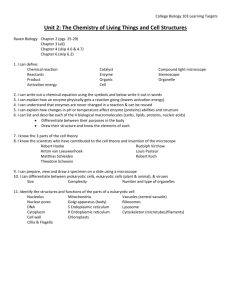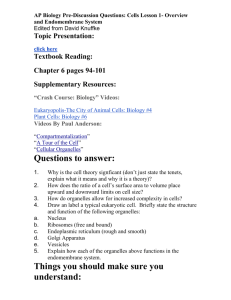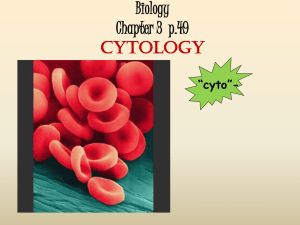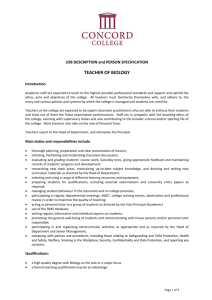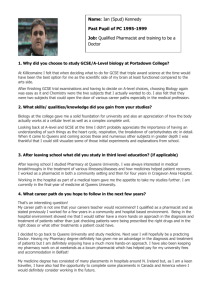Biology 2014 Introduction to year 12 Biology booklet
advertisement
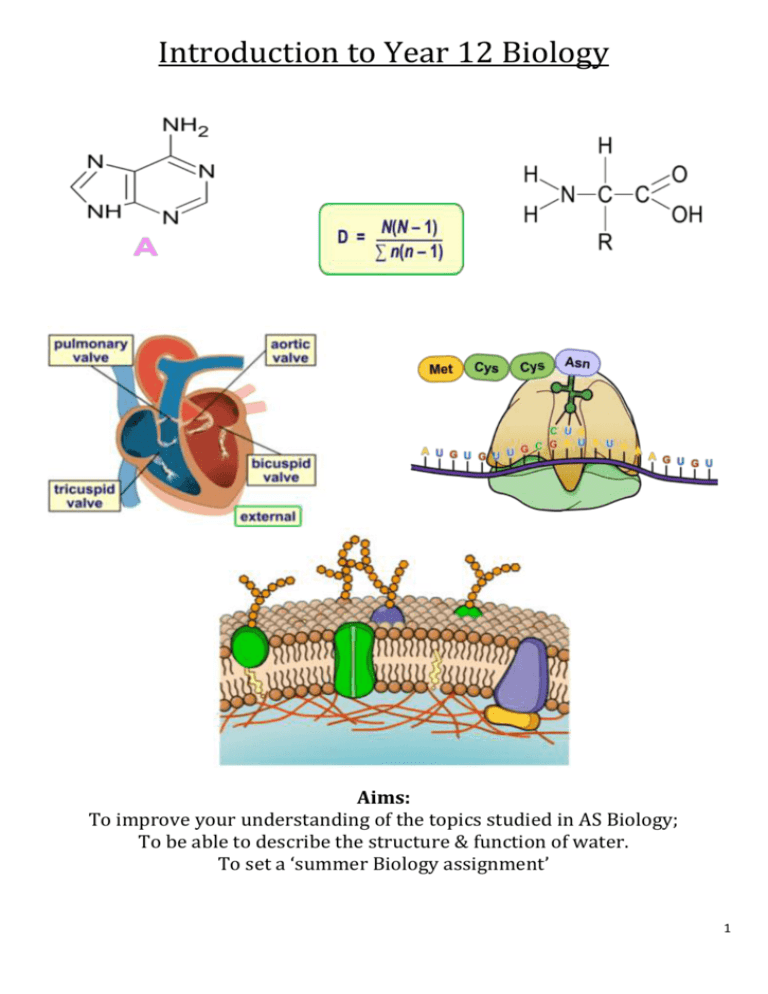
Introduction to Year 12 Biology Aims: To improve your understanding of the topics studied in AS Biology; To be able to describe the structure & function of water. To set a ‘summer Biology assignment’ 1 WATER, WATER EVERYWHERE. Complete the spider diagram below to describe all the things you know about water, structure, bonding and function (uses) in plants & animals. Water: 2 Work in groups of two or three. Use the resources provided to carry out the following tasks: Use the molymods to make a water molecule. Draw this in 3D: Turn on the tap slowly. Why do the water molecules stick together? This explanation can be linked to the molecular structure of water. Take two microscope slides, put a thin layer of water between them, and choose one in your group to pull them apart. Explain your observation. Put one of each size of the glass tubes into the coloured water. Write down the results for each one. Explain your results. Look at the ice on the water. Why does the ice form on the surface first? What is the significance of this to living things? 3 Structure of year 12: Unit 1 (30%) 1 Hour Examination May 2015 Cells: Microscopy; Cell structure & organelles; Plasma (cell) membrane structure & function; Cell cycle & mitosis; Exchange & transport: Structure & function of the lungs; Structure & function of the mammalian heart; Structure & function of blood vessels; Transport of oxygen & carbon dioxide; Structure & function of xylem & phloem; Transpiration & translocation. Unit 2 (50%) 1 hour 45 minute Examination June 2015 Biochemistry: Structure & function of: Carbohydrates; proteins; lipids; nucleic acids Structure & function of water; Enzyme – structure & function Food & health: Diet; Food production; Microorganisms; Disease; Immunity; Drugs; Smoking; CVD & CHD; Biodiversity & evolution: Biodiversity; Sampling animals & plants; Classification & taxonomy; Variation & adaptation; Natural selection; Evolution; conservation Practical skills – completed in January 2015 (20 %) Qualitative skill Total /10 Practical Quantitative skill Total/ 10 Practical Evaluative skill Total / 20 Written paper 4 5 6 Summer project Complete the following tasks and present in a NEAT format: 1. Labelled diagram of an animal cell and plant cell (A level standard): 2. Copy & complete the following table: organelle structure function Diagram: Nucleus Smooth Endoplasmic reticulum Rough endoplasmic reticulum Golgi apparatus Mitochondria Chloroplast Lysosomes Ribosomes centrioles 3. Labelled diagram of the internal & external structure of the mammalian heart, (A level standard) 4. Labelled diagram of a transverse section of a plant leaf, root & stem, (A level standard) Help: The following web sites may be useful: http://www.biologymad.com http://www.s-cool.co.uk/a-level/biology/cells-and-organelles/revise-it/organelles http://www.s-cool.co.uk/a-level/biology/transport http://www.mrothery.co.uk/cells/cellnotes.htm All diagrams must be hand drawn & in pencil Complete the past paper questions Revise pages -1, 2, 3, 31 & 32 YOU WILL NEED TO PURCHASE A WHITE LABORATORY COAT, TO ALLOW YOU TO PARTICIPATE IN PRACTICAL LESSONS You will need to purchase a copy of Head Start to AS Biology. If you haven’t got one go to the CGP web site or Amazon and order. It retails at £5 and has an ISBN: 978 -1847621177. It recaps all the tricky topics from GCSE that AS builds on… so you won’t have to! Ideal preparation for September no matter what GCSE option you have followed. It will also be useful for reference throughout the course. 7
